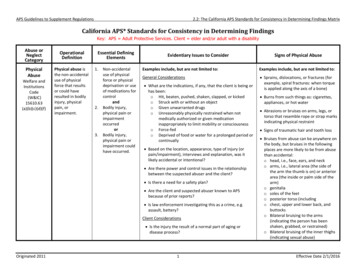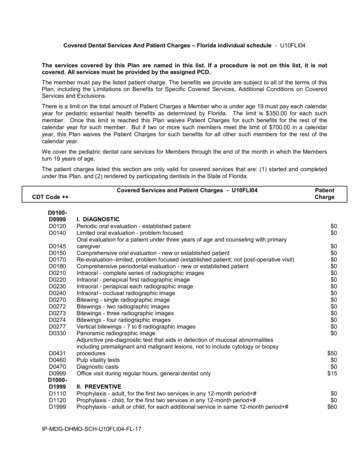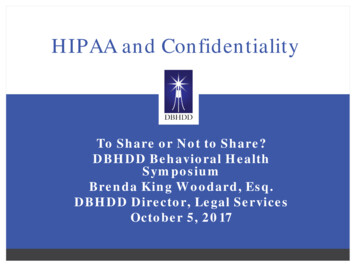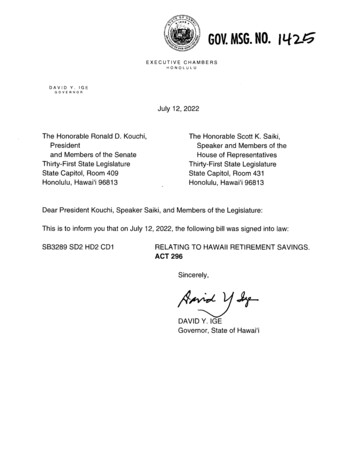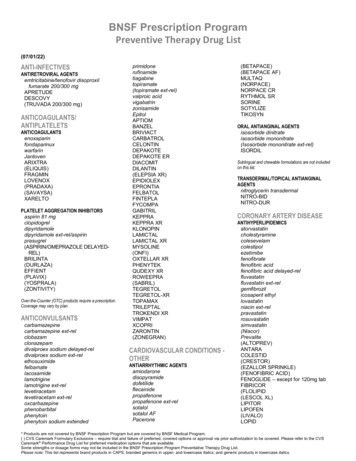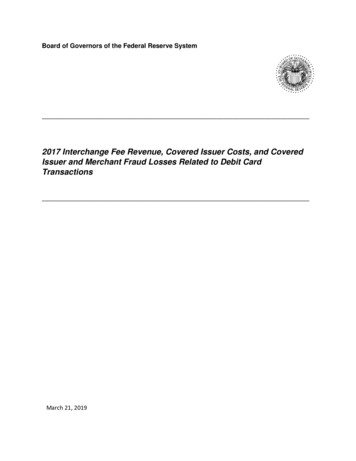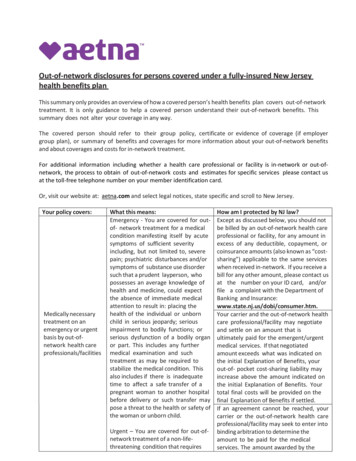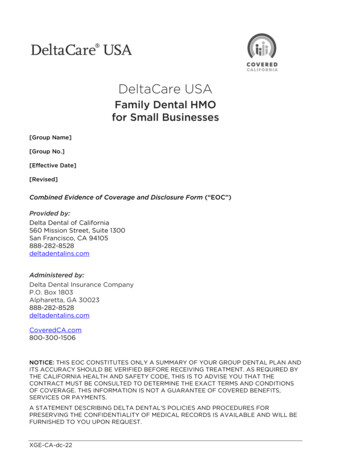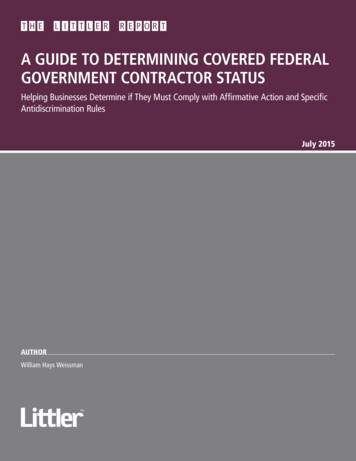
Transcription
A GUIDE TO DETERMINING COVERED FEDERALGOVERNMENT CONTRACTOR STATUSHelping Businesses Determine if They Must Comply with Affirmative Action and SpecificAntidiscrimination RulesJuly 2015AUTHORWilliam Hays Weissman
IMPORTANT NOTICEThis is not a do– it– yourself guide to federal contracting law or compliance with federal affirmative action or antidiscrimination laws.Rather, it is intended solely as a guide to help companies understand the parameters that could cause a business to be covered by suchlaws and the potential compliance costs and burdens if they are. This paper is not a substitute for experienced legal counsel and doesnot provide legal advice.Copyright 2015 Littler Mendelson, P.C.All material contained within this publication is protected by copyright law and may notbe reproduced without the express written consent of Littler Mendelson.
Table of ContentsSECTION / TOPICPAGEEXECUTIVE SUMMARY1CASE STUDY: THE UNSUSPECTING SUBCONTRACTOR2DETERMINING IF YOU MUST COMPLY: THE METHODOLOGY4THE THRESHOLD REQUIREMENTS FOR COMPLIANCE4STEP ONE: THE RED FLAG CHECKLIST5STEP TWO: EVALUATING THE INFORMATION6666Direct Government ContractsSubcontract To An Ultimate Government ContractSingle Entity AnalysisTHE 50– 50 DECISION TREE7STEP THREE: REVIEWING COMPLIANCE RISKS888Compliance ObligationsRamifications of NoncomplianceCONCLUSION9APPENDIX A: PRIMARY LAWS SPECIFICALLY AFFECTING COVEREDFEDERAL GOVERNMENT CONTRACTORSExecutive Order 11246 and OFCCP RegulationsLaws Preventing Discrimination Against the DisabledLaws Preventing Discrimination Against VeteransOther Obligations Imposed On Covered Federal Government ContractorsAPPENDIX B: WILLIAM HAYS WEISSMAN BIOOFCCP/Affirmative Action ExpertiseEmployment Tax ExpertiseAdvising Employers On Talent ManagementContact InformationCOPYRIGH T 2015 L I T T L ER MENDEL SON, P.C.10101011121313131313i
iiLITTLER MENDELSON, P.C. EMPLOYMENT & L ABOR L AW SOLUTIONS WORLDWIDE
A GUIDE TO DETERMINING COVERED FEDERAL GOVERNMENT CONTRACTOR STATUSHelping Businesses Determine If They Must Comply With Affirmative Action and Specific Antidiscrimination RulesEXECUTIVE SUMMARY1The Issue: Having a federal government contract or subcontract can obligate a business to comply with substantial affirmative actionobligations. Knowing whether such a contract triggers these obligations is critical and allows a business to properly evaluate the contract’strue benefits and burdens. A business should not learn of these obligations for the first time in a government audit that could result insignificant financial costs.The Question: Do you need to comply with the affirmative action and specific antidiscrimination requirements that are imposed oncovered federal government contractors?Determining If You Must Comply: The “50– 50” Test Does the company have more than 50 employees AND A single contract worth at least 50,000 that is: With the federal government directly; OR With a federal government contractor to provide goods or services that are either “necessary” to the performance of the ultimatecontract with the federal government or that fulfills a part of the direct contractor’s agreement with the federal government; OR Are you part of a “single entity” that is a covered federal government contractor?If you answer YES, then your company must comply with the following requirements: Affirmative action plans (AAPs) Detailed recordkeeping Posting and notice requirements Submission to auditsThe Ramifications of Noncompliance: Failure to prepare AAPs and keep detailed records can lead to significant back pay awards,notices of violations, years of federal government oversight, negative public press and possible disbarment.What You Should Do Now: Determine if your company needs to comply. Get into compliance before being audited.1 This is not a do– it– yourself guide to federal contracting law or compliance with federal affirmative action or antidiscrimination laws. Rather, it is intendedsolely as a guide to help companies understand the parameters that could cause a business to be covered by such laws and the potential compliance costs andburdens if they are. This paper is not a substitute for experienced legal counsel and does not provide legal advice.COPYRIGH T 2015 L I T T L ER MENDEL SON, P.C.1
A GUIDE TO DETERMINING COVERED FEDERAL GOVERNMENT CONTRACTOR STATUSCASE STUDY: THE UNSUSPECTING SUBCONTRACTORIn OFCCP v. Monongahela Railroad Company,2 the Office of Administrative Law Judges (OALJ) addressed whether the Office of FederalContract Compliance Programs (OFCCP) had jurisdiction over a company that sold goods to another company that contracted withthe federal government. The facts in Monongahela Railroad Company are typical of many subcontractor relationships with covered federalgovernment contractors. The Monongahela Railroad Company (“Monongahela Railroad”) transported coal by rail for a portion of the tripfrom the coal mines to Detroit Edison’s Monroe, Michigan, power plant. Detroit Edison contracted with the federal government’s GeneralServices Administration (GSA) to supply electric and steam service to federal facilities from all of the company’s power plants includingthe Monroe plant. The federal government used approximately 0.4 percent of the electricity generated by Detroit Edison on a yearly basis.When the OFCCP sought to audit the railroad, Monongahela Railroad objected, asserting it was not a government subcontractor. Itargued that its services were not necessary to Detroit Edison’s government contract because Detroit Edison produced electricity withoutinterruption even when the railroad did not transport any coal to it. The OALJ rejected that argument, pointing out that “[a]s the type ofservice provided by defendant, i.e. the transportation of coal, is necessary to the performance of Detroit Edison’s government contract tosupply electricity, defendant meets the definition of a subcontractor in the regulations.”The railroad also argued that there was no way to prove that its coal was used to produce the electricity that was sold to the GSA, andthat the amount of electricity purchased by the government from Detroit Edison was so minimal that the coal the railroad sold created “sucha weak and tenuous connection to the provision of contractual services to the government that it cannot be considered a subcontractor.” Inrejecting this argument, the OALJ found that once it was determined that the coal was “necessary” to the government contractor, “it shouldnot make any difference whether the defendant’s contribution to the government contract is large or small, significant or insignificant.”Accordingly, Monongahela Railroad was found to be a covered federal government contractor, and thus required to comply with affirmativeaction obligations.As the Monongahela Railroad Company case study demonstrates, a business can become a covered federal government contractor notonly by directly contracting with the federal government, but by being a subcontractor to a federal government contractor. Further, thesubcontractor can become covered even if the connection between the goods and services provided and the ultimate government contractis minimal or remote. Moreover, the company will be obligated to comply even if it does not know there is an ultimate federal governmentcontract and its contract does not reference equal employment opportunity language or related affirmative action and antidiscriminationobligations.Key Takeaway: A company will have affirmative action obligations if the cost of what it sells is more than 50,000 and necessary to anultimate government contract, whether minimal, remote or even unknown to the company. Therefore, knowing whether contracts triggersuch obligations is critical.2OFCCP v. Monongahela Railroad Co., 85– 0FC– 2 CALJ (Apr. 2, 1986), aff’d Mar 11, 1987.2LITTLER MENDELSON, P.C. EMPLOYMENT & L ABOR L AW SOLUTIONS WORLDWIDE
A GUIDE TO DETERMINING COVERED FEDERAL GOVERNMENT CONTRACTOR STATUSA business can also become a covered federal government contractor by being a part of a “single entity” that includes a covered federalgovernment contractor. A “single entity” is defined as a closely integrated corporate family that generally shares common ownership,management and controls or operations. A business that is part of a single entity that includes a federal government contractor will haveaffirmative action obligations even though the business has no involvement in the federal government contract. Accordingly, there aremultiple ways that businesses can become covered federal government contractors, and in particular two possible ways – subcontractingand being part of a single entity – that can come as an unpleasant surprise to a business.The purpose of this Guide is not to suggest that businesses should avoid becoming covered federal government contractors. Rather, whatshould be avoided is the surprise of realizing the business is a covered federal government contractor without having taken the opportunity toweigh the costs and benefits of covered federal government contractor status. Your business should have full information about what federalgovernment contractor status entails in order to make an intelligent business decision about whether to sell goods and services to the federalgovernment, whether directly or indirectly.This Guide contains: A simple methodology to help companies identify whether they are a covered3 federal government “supply and service” contractor,4including: The Red Flag Checklist to help gather necessary information; and The 50– 50 Decision Tree to aid in analyzing whether a company must comply; An explanation of the compliance obligations costs; A discussion of the ramifications of noncompliance; and An appendix that provides summaries of the major laws and compliance obligations that apply to covered federal governmentcontractors.3 For purposes of this Guide, a “covered” federal government contractor simply means a contractor that meets the minimum requirements that triggeraffirmative action and specific antidiscrimination obligations.4 A business can also be a covered federal government construction contractor. The thresholds and requirements for covered construction contractors aresomewhat different than the requirements for “supply and service” contractors. This Guide does not address federal government construction contractors.COPYRIGH T 2015 L I T T L ER MENDEL SON, P.C.3
A GUIDE TO DETERMINING COVERED FEDERAL GOVERNMENT CONTRACTOR STATUSDETERMINING IF YOU MUST COMPLY: THE METHODOLOGYSTEP ONE: Use the Red Flag Checklist to gather the information needed to evaluate whether your company satisfies the “50– 50” Test.STEP TWO: Use the 50– 50 Decision Tree to evaluate the information gathered with the Red Flag Checklist to determine if yourcompany must comply.STEP THREE: If, after evaluation, you determine your company must comply, review your practices and procedures against therequirements imposed on covered federal government contractors and take corrective action as needed. In addition, evaluate the ongoingcosts of compliance to determine the relative benefits and burdens of being a covered federal government contractor.STEP FOUR: Repeat this process on a regular basis as circumstances change.THE THRESHOLD REQUIREMENTS FOR COMPLIANCEMerely having a contract to supply goods or services to the federal government does not obligate a company to be in compliance with theregulations governing covered federal government contractors. Rather, apply the “50– 50” Test to determine if the threshold requirementsare satisfied:AT LEAST 50 employees AND 50,000 contract covered federal government contractor50 Employee Requirement:5 If the company has less than 50 full– time employees, it will not be a covered federal government contractor,even if it has a contract worth more than 50,000. 50,000 contract requirement: The 50,000 contract does not need to be directly with the federal government. Rather, the 50,000contract with the federal government may arise from one of four possible contracting relationships:1) Direct federal government contract;2) Direct federal government contract by another division of your company;3) Subcontract for necessary goods or services to an ultimate government contract; or4) Contract by another company that is part of the same single entity as your company.Note: “Federal financial assistance” (which means loans or grants of federal funds) is not a “contract” for purposes of the “50– 50” Test,and thus does not trigger covered federal government contractor status even if more than 50,000. Medicaid is an example of federalfinancial assistance.The Red Flag Checklist: The Red Flag Checklist on the following page guides you through potential sources of information to checkto determine whether your company meets the 50,000 contract threshold requirement. Once you have gathered the necessary information,you can use the 50– 50 Decision Tree under Step Two to determine if you must comply with the requirements imposed on covered federalgovernment contractors.5 There are some minimal compliance burdens if the business has a contract worth at least 10,000, but they effectively overlap the antidiscriminationrequirements of Title VII, and thus are not likely to cause companies any significant compliance burdens or subject the company to OFCCP audit risk.4LITTLER MENDELSON, P.C. EMPLOYMENT & L ABOR L AW SOLUTIONS WORLDWIDE
A GUIDE TO DETERMINING COVERED FEDERAL GOVERNMENT CONTRACTOR STATUSSTEP ONE: THE RED FLAG CHECKLISTYESNOSOURCES OF INFORMATION TO GATHER TO ADDRESS THE FOLLOWING FOUR QUESTIONS1.2.3.4.Do you have a federal government contract for 50K? Ask your procurement personnel. Check the federal procurement databases. Check EEO– 1 forms, Question C– 3.Do you have a branch office/division with a federal gov’t contract 50K? Ask your divisions and branch offices. Check the federal procurement databases. Check all EEO– 1s, Question C– 3.Do you do 50K business with a federal gov’t contractor? Get a list of customers that you do 50K business with. If you have an initial contract 50K, has it been added to or amended to increase the total amount to 50K? Review for obvious federal government contractors. Check the federal procurement databases. Check contracts 50K for incorporation language or reference to: Executive Order 11246 41 C.F. R. Part 60; Vietnam Era Veterans’ Readjustment Assistance Act of 1974, as amended; Section 503 of the Rehabilitation Act of 1973, as amended; Jobs for Veterans Act of 2002; FARs (52.222– 26, – 35, – 36, – 54). Check for contractor certification forms. Is what you provide necessary to your customer’s gov’t contract?Are you part of a tightly controlled corporate group that includes a covered federal government contractor? Ask your parent, subsidiaries and sister companies if they are covered federal government contractors. Check the federal procurement databases for parent, subsidiaries, and sister companies. If yes, conduct a Single Entity analysis.COPYRIGH T 2015 L I T T L ER MENDEL SON, P.C.5
A GUIDE TO DETERMINING COVERED FEDERAL GOVERNMENT CONTRACTOR STATUSSTEP TWO: EVALUATING THE INFORMATIONDirect Government ContractsEvaluating direct government contracts is usually rather straightforward, even if the contract is with another division or office of thesame legal entity. Thus, it is usually possible to readily determine whether you are a covered federal government contractor by locating andreviewing such contracts.Subcontract to an Ultimate Government ContractThe more difficult question to analyze is whether you have a subcontract that is necessary to someone else’s federal government contract.You need not be the first tier subcontractor to be covered. For example, if you sell ball bearings to a company that manufactures jet enginesthat are sold to a company that manufactures jet airplanes under a contract to sell them to the U.S. Air Force, the ball bearings are likely“necessary” to the ultimate government contract for the sale of jet airplanes to the Air Force. Thus, the company manufacturing ball bearingslikely has affirmative action obligations, even if it was unaware that its ball bearings were eventually going to the Air Force.6 Step One: Determine if you are selling at least 50,000 of goods or services to a covered federal government contractor or coveredsubcontractor. Step Two: Determine if what you are selling is necessary to the government contract.Determining what is necessary is not always easy. Certain kinds of administrative services or “back office” functions may or may not benecessary to the performance of the government contract. For example, in Liberty Mutual Insurance Company v. Friedman,7 the court heldthat the OFCCP did not have jurisdiction over the insurance company merely because it provided blanket worker’s compensation coverageto government contractors. Nonetheless, employers should not assume that such services are always unnecessary to an ultimate federalcontract without undertaking a thorough analysis.Single Entity AnalysisA company that has nothing to do with federal government contracts may still qualify as a covered federal government contractor ifit is part of a tightly controlled corporate family known as a single entity “single entity” with a parent, subsidiary or sister company that isa covered federal government contractor. Further, two companies that separately might not be covered may, when combined, become acovered federal government contractor. For example, in OFCCP v. Manheim Auctions, Inc.8 there were two companies, one with a governmentcontract worth more than 50,000 but having less than 50 employees, and the other entity with no government contract but having morethan 50 employees. While neither entity standing alone qualified as a government contractor, as a single entity they both did because theseparate legal status is ignored for purposes of determining obligations under the EO and regulations. Thus, both entities were covered andrequired to comply with recordkeeping and reporting (AAP) obligations.The test used to determine whether a corporate family constitutes a “single entity” for purposes of subjecting all members companies tothe compliance requirements is similar to the test used under Title VII and the National Labor Relations Act, and is a facts and circumstancestest that takes into account five general factors: Do the entities have common ownership? Do the entities have common officers and directors? Does one of the entities exert day– to– day control over the other companies through policies, management, and supervision of theother companies’ operations? Do the companies have common or centralized personnel policies? Are the operations dependent upon each other or principally for the benefit of each other, such as shared management, officespace, or other services?96 The affirmative action obligations apply to covered subcontractors as a matter of law regardless of whether the subcontractor’s contract contains reference tothem. Thus, it is not an excuse to assert that the contract did not put the subcontractor on notice of the potential affirmative action obligations. However, thisdoes help explain why subcontractors are often surprised, and why making these determination is so critical. See, e.g., OFCCP v. UPMC Braddock,2007– OFC– 0 01 (May 29, 2009), at 4– 5.7 Liberty Mut. Ins. Co. v. Friedman (4th Cir. 1981) 639 F.2d 164.8OFCCP v. Manheim Auctions, Inc., DOL OALJ, No. 2011-OFC-00005, June 14, 2011.9 Single entity analysis is complex and complicated. The OFCCP uses a 27–question test that can be distilled down into these five factors that are typically usedby the courts. The point here is that even if a company does not do business with the federal government, it may still become a covered federal governmentcontractor if it is part of a tightly controlled corporate family that includes a covered federal government contractor. Unless a company knows about thepotential for covered status it cannot make intelligent business decisions that take those affirmative action obligations into consideration.6LITTLER MENDELSON, P.C. EMPLOYMENT & L ABOR L AW SOLUTIONS WORLDWIDE
A GUIDE TO DETERMINING COVERED FEDERAL GOVERNMENT CONTRACTOR STATUSThus, when a company is part of a corporate family, it must make inquiries not only of itself or its branches and divisions, but of the othercompanies in its corporate family using the same sources of information that it would review for direct contracts or subcontracts (see theRed Flag Checklist). If one company turns out to be a covered federal government contractor, then it must be determined whether it willbe treated as part of a single entity with any other companies in the corporate family under the test outlined above. With careful planning, itis possible to isolate covered federal government contractors so that not all related companies become part of a single entity. Again, however,a company must know about the potential for being a covered federal government contractor before it can plan to isolate such risk.50– 50 Decision Tree: The 50– 50 Decision Tree below provides a simple way to analyze whether a company meets the minimumrequirements for being a covered federal government contractor.SubcontractsDo you have morethan 50 employees?THE 50– 50 DECISION TREE10NONOYESDo you have a contract with afederal government contractoror subcontractor worth at least 50,000?Do you have morethan 50 employees?YESNONOYESIs what you sell to the federalgovernment contractor orsubcontractor necessary to theultimate direct contract withthe federal government?Direct ContractsDo you have a contract with afederal government contractoror subcontractor worth at least 50,000?YESNOYESNOT COVEREDCOVERED10 “You” in this decision tree refers to the legal entity, whether standing alone or as part of a single entity. Thus, whether “you” have 50 employees may be basedon your own workforce, or the combined workforce of all companies that comprise the single entity, and the same principles apply to a contract worth at least 50,000.COPYRIGH T 2015 L I T T L ER MENDEL SON, P.C.7
A GUIDE TO DETERMINING COVERED FEDERAL GOVERNMENT CONTRACTOR STATUSSTEP THREE: REVIEWING COMPLIANCE RISKSIf you determine that your company must comply with the requirements imposed on covered federal government contractors, youshould determine your level of compliance, take steps to get into compliance, assess the risks of noncompliance, and evaluate the benefitsand burdens of ongoing covered federal government contractor status.Compliance Obligations EEO Compliance Personnel: A covered federal government contractor may need dedicated personnel to handle the obligationsassociated with being a covered federal government contractor. These personnel costs are often a hidden cost of compliance whenevaluating the potential profit from a government contract and can be expensive depending upon the number of dedicated personnel. AAPs: AAPs can cost several thousands of dollars to prepare each year. A company generally must prepare one for each locationthe company has with more than 50 employees. As a result, a large company can have dozens of AAPs. Detailed Recordkeeping: Continuous tracking of all applicants and ongoing analysis of all employment activity may requireexpensive upgrades to human resource information systems (HRIS). Data tracking must include: Tracking the race and gender of applicants, and the race, gender, veteran status, and disability status of employees. Detailed statistical analyses, including:(1) applicants, hires;(2) competitive promotions, non– competitive promotions;(3) voluntary terminations, layoffs, involuntary terminations; and(4) compensation. Audits: The OFCCP has a right to audit covered federal government contractors. Audits can last for years, and coveredfederal government contractors can incur thousands of employee hours responding to burdensome information requests. Companywide Obligations: Once a company becomes a covered federal government contractor, the complianceobligations apply to the entire company, not just the particular location or division involved in federal contracts. Thus, anyfacility could be audited, even if it has no involvement in the federal government contract.Ramifications of Noncompliance Audits: The Obama Administration has been aggressively auditing covered federal government contractors, issuing notices ofviolations and seeking substantial monetary remedies. As a result, covered federal government contractors have a strong incentiveto pay careful attention to whether: (1) they are covered federal government contractors: and (2) the requirements for compliance.If a company is subject to audit and has not been in compliance, it is unlikely to have the necessary documentation to explain anydiscrepancies in hiring, promotion, termination or compensation that the OFCCP determines exist. Back Pay Awards: The OFCCP has been seeking more back pay awards, usually two years plus interest, based on alleged patternsof discrimination against women or minorities. For example, if the OFCCP accuses a company of having discriminated against 10women in hiring into a position that pays 50,000 per year (including the value of benefits), it can seek a back pay award of 1 million( 50,000 annual pay for two years times 10 women), plus additional interest. Thus, back pay awards can be substantial. Conciliation Agreements: The OFCCP now generally demands noncompliant contractors to enter into Conciliation Agreementsfor one, two, or more years (depending on the nature of the violation) that require additional reporting requirements and subject thecompany to continued scrutiny and oversight. Negative Press: The OFCCP often issues press releases when a monetary settlement in a hiring discrimination case is more than 100,000, indicating how many victims of discrimination are receiving remedies and how many preferential hires the companymust make in the future. Such press releases can create negative public perceptions that have other unintended consequencesfor companies.8LITTLER MENDELSON, P.C. EMPLOYMENT & L ABOR L AW SOLUTIONS WORLDWIDE
A GUIDE TO DETERMINING COVERED FEDERAL GOVERNMENT CONTRACTOR STATUSKey Takeaway: Compliance costs can outweigh the profit from a federal contract, as even a single back pay award could wipe out totalcontract revenues, let alone profits. Thus, it is critical for businesses to know what those compliance costs and risks are when determiningthe benefits of covered federal government contractor status.CONCLUSIONIt is critical for businesses to know if they are covered federal government contractors so that they can properly evaluate a contract’scosts and burdens, in addition to the benefits, and make intelligent business decisions based on full information. The costs of compliance canbe significant, and costs of noncompliance even more so, such as to make any profits from government contracts illusory.Many businesses can become covered federal government contractors without knowing it or actively seeking to become federalgovernment contractors. Thus, companies should evaluate on a regular, periodic basis whether they are a covered federal governmentcontractor and take steps to address compliance if they are. Companies should seek qualified counsel to help evaluate their status and ensurecompliance with all affirmative action and antidiscrimination obligations.COPYRIGH T 2015 L I T T L ER MENDEL SON, P.C.9
A GUIDE TO DETERMINING COVERED FEDERAL GOVERNMENT CONTRACTOR STATUSAPPENDIX A: PRIMARY LAWS SPECIFICALLY AFFECTING COVERED FEDERAL GOVERNMENT CONTRACTORSExecutive Order 11246 and OFCCP RegulationsExecutive Order 11246 prohibits discrimination in employment by federal government contractors on account of race, color, religion,sex, or national origin. Further, companies must engage in activities designed to ensure that all employees and candidates for employmentare treated without regard to race, color, religion, sex, or national origin. These activities are known as “affirmative action.”The OFCCP, which is part of the United States Department of Labor, audits federal government contractors for compliance with theseaffirmative action and non– discrimination laws. Under the OFCCP’s regulations (promulgated under 41 C.F.R. §§ 60– 1 et seq.), a coveredfederal government contractor must annually prepare an affirmative action plan (AAP) and related documents and analyses. A separate AAPis generally required for each “establishment” or company location. Thus, a business could have dozens of AAPs depending upon the size ofthe company. An AAP must include the following information: Organizational profile or workforce analysis; Job group analysis; Placement of employees in job groups; Determination of availability of women and minorities for jobs in each job group; Comparison of percentage of employees in each job group to their estimated availability in the labor market and within the company; Placement goals; Designation of company personnel responsible for implementing the AAP; Identification of Problem Areas (analysis of its employment process to determine whether and where impediments to equalopportunity exist), which at a minimum include a detailed evaluation of the following: The workforce by organizational unit and job group to determine whether there are problems of minority or female utilizationor of minority or female distribution; Personnel activity (applicant flow, hires, terminations, promotions, and other personnel actions) to determine whether there areselection disparities; Compensation systems to determine whether there are gender– , race– , or ethnicity– based disparities; Selection, recruitment, referral
government contractor status entails in order to make an intelligent business decision about whether to sell goods and services to the federal government, whether directly or indirectly. This Guide contains: A simple methodology to help companies identify whether they are a covered 3 federal government "supply and service" contractor, 4


